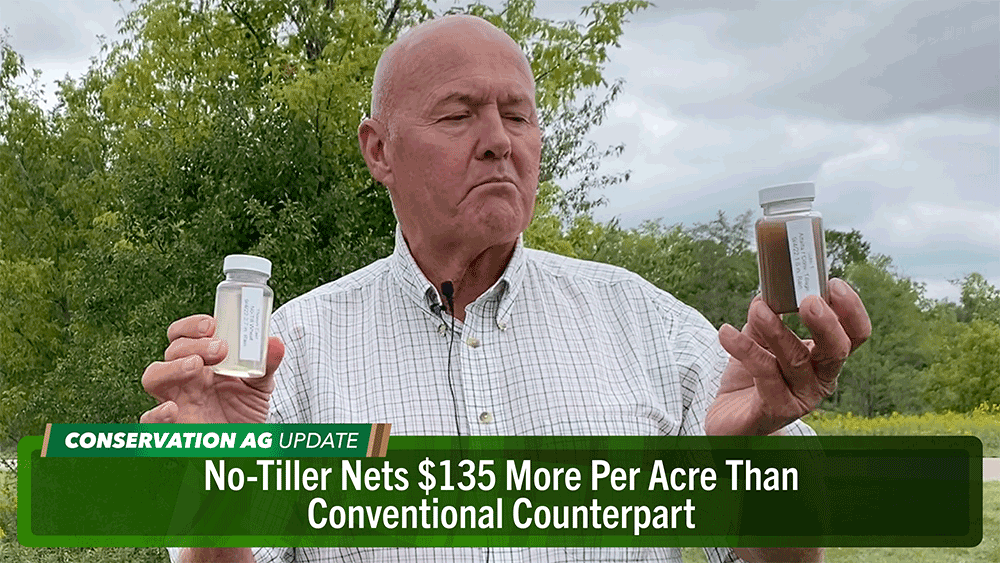On this episode of Conservation Ag Update, a group of no-tillers gather in southwestern Wis., to carry on Dave Brandt’s vision of a farmer-led learning center at the Sinsinawa Mound Center. Plus, Stockton, Ill., no-tiller Greg Thoren shares how he’s netting $135 more per acre than his peers who practice conventional tillage.
Also in the episode, assistant editor Mackane Vogel reports from the FIRA USA conference in Salinas, Calif., with a look at an innovative weeding system in action for the first time.
In the Cover Crop Connection segment, Tuscola County, Mich., no-stiller Jeff Schluckbier details how cover crops are paying off in his 7,500-acre operation, especially during heavy rainfall events. And the Video of the Week features sights and sounds from the Cedar Creek Farmers Fall Field Day, including cover cropping drones and a presentation on closing wheels.
This episode of Conservation Ag Update is brought to you by Yokohama Off-Highway Tires.
VF tires are constructed with sidewalls that enable them to bear heavier loads and operate at lower inflation pressures than traditional radial tires. In fact, VF tires, like our Alliance AgriFlex+ range, can carry up to 40% more load than a conventional radial tire at the same inflation pressure or operate at up to 40% lower air pressure under the same load. VF tires offer quantifiable improvements on the farm. For example, the ability to carry heavier loads can cut down significantly on fuel use and reduce machine hours, while the ability to operate at lower inflation pressures allows tires to produce larger footprints, which can improve traction and reduce soil compaction. The best part is, you can choose which benefit works best for your operation. Learn More at https://yokohama-oht.com.
TRANSCRIPT
Jump to a section or scroll for the full episode...
- No-Tillers Carry on Dave Brandt’s Vision for Farmer-Led Learning Center
- Farmer Feature: Greg Thoren, Stockton, Ill.
- Future of Farming on Display at FIRA USA 2023
- Cover Crop Connection: Cover Crops Pay Off After Heavy Rains
- Closing Wheels, Drones Highlighted at Cedar Creek Farmers Field Day
No-Tillers Carry on Dave Brandt’s Vision for Farmer-Led Learning Center
Welcome to Conservation Ag Update! Great to have you with us for another jam-packed episode. Let’s start with a special event in southwestern Wisconsin aimed at fulfilling the vision of the late Dave Brandt.
A group of no-tillers and supporters from across the U.S. gathered at the Sinsinawa Mound Center, where Brandt, before his unexpected death, had been working with the Dominican Sisters of Sinsinawa to turn some of the buildings at the site into a farmer-led learning center.
Several no-tillers picked up the torch and formed a steering committee to carry on his vision. Among them is No-Till Innovator Loran Steinlage, who told the crowd, “What we create here could be the future of agriculture.” Dave’s son, Jay Brandt, emphasized multiple times throughout the 2-day event that his dad wanted the center to be locally led with a strong, farmer-first vision.
“This is our call to everyone here today, that we want to start with local farmer-led, at that local small level and build that capacity and learning potential.”
There were lots of ideas shared about what the center could become. If you want to get involved, contact Loran Steinlage at flolofarms@gmail.com
Farmer Feature: Greg Thoren, Stockton, Ill.
Stepping into the spotlight this week is Greg Thoren of Stockton, Ill. He no-tills corn, soybeans, wheat and cereal rye in the Land of Lincoln.
And check out how clean the water is coming off his cover cropped field after nearly 3 inches of rain, compared to water from a neighbor’s conventionally tilled field on the right of your screen. Greg’s conservation practices are also helping his bottom line, and he has the numbers to prove it.
“Our actual yield last year was 185 bushels per acre. The conventional people that we work with had averaged 215 bushels per acre. They compared their expenses per acre on corn to mine. Their gross revenue was approximately $195 more per acre than mine. We pulled the expenses off —I had $335 less expenses in my crop than they did. I actually ended up netting $135 more per acre than the conventionally produced corn crop last year.”
Bushels per acre don’t pay the bills, net return pays the bills, Thoren says. Keeping the banker happy and the wife happy.
Future of Farming on Display at FIRA USA 2023
FIRA USA 2023 is taking place in Salinas, Calif., this week. Mackane Vogel checks in now from the conference, where the latest autonomy and ag robotics innovations are on display.
This morning we had a chance to chat with Jose Marchetti. He is a regional manager for Ecorobotix. And we got a chance to check out a demo of the ARA — this is a really innovative weeding system. we’ll let you take a look. Here is Jose to tell you a little bit more about it.
“It's a very compact sprayer with tanks in the front for the mixture and clean water. Then all the fluidic systems that come to the back. And in the back, we have three sections, each of them. With two computers, and each of the computers with a set of cameras and very strong flashlights that are taking the pictures of the field. Basically what we are doing is mapping the field, identifying what is the crop, what is the weed, and depending on what the grower wants to do, you can target one or the other. So, the unique benefits are a big reduction on the feto sanitary products that you use up to 95% depending on the stages and on the weed infestation that the field can have. But on average, our customers are having around 70 to 75% of feto sanitary products reduction.
Then secondly, the crops grow more healthier because many of the selective products we are using nowadays has made some damage on the crop. The crop needs to de intoxicate themselves from, from these selective herbicides.
So when you avoid spraying these products, the crops grow healthier. So you can get a significant increase in yield and, not residue at all on the plants. Third benefit is that you do all of this with practically no drift because of the design of the machine that it is all covered on the sides.
And, fourth bar, last but not least is, uh, that we can help reducing the manual labor significantly.”
Stay tuned for more videos from FIRA USA 2023 in the coming weeks.
Cover Crop Connection: Cover Crops Pay Off After Heavy Rains
Today we’re talking with Jeff Schluckbier, who grows corn, sugar beets and wheat in Tuscola County, Mich. Jeff uses sunflowers, radish, clover, oats, cereal rye and Austrian winter peas. He says cover crops are paying off big time in his 7,500-acre operation, especially during heavy rainfall events.
“In Michigan, we tend to not get nice, gentle rains anymore. We get these angry rains and thunderstorms. Years ago, I can remember a couple fields in the area here after a 2–3-inch rain, you’d have water sitting everywhere for the better part of the afternoon. Now after these 2–3-inch rains, the water’s gone in a half hour. I think over the years our cover cropping, whether it’s the radishes or sunflowers or clover, it’s making our ground looser and helping handle the big rains we get throughout the growing season.”
Video of the Week: Closing Wheels, Drones Highlighted at Cedar Creek Farmers Field Day
And we’re back in the main studio now to wrap things up with our video of the week, featuring sights and sounds from the Cedar Creek Farmers Fall Field Day.
Jeramy Williams, owner of American Drone, showed off one of his bigger drones, using it to apply cover crops on a soybean field in Cedarburg, Wis. The drone can hold up to 65 pounds of seed and runs autonomously up to 16 mph across the field.
Also during the field day, Chuck Gruenberger of Riesterer & Schnell gave a presentation on no-till equipment. Let’s listen in as Chuck goes over some of the newer closing wheels on the market.
“SI has a seed disc — cast iron — no-till this is one of the better rated ones by Beck’s Seeds because it’s heavy, you get weight, plus you get the penetration of the knobs on the outside. It has an automatic built-in depth control so the knobs on this side prevent it from digging too deep. It’s a heavy unit. The new one this year that I’ve delt with is this Zipper Wheel. It’s also cast iron, it’s not as heavy as the SI. But the knobs on the outside instead of being straight are kind of angled, which helps close that seed trench. There are lots of options out there. Watch videos, do your own research. I sell them all. I don’t have an opinion on which is best. They all do a job.”
Have an interesting photo or video from your farm? Or a story you’d like us to feature on the broadcast? Send me an email at Nnewman@lesspub.com.
And that will wrap things up this edition of Conservation Ag Update. Until next time, for more stories visit no-tillfarmer.com, striptillfarmer.com and covercropstrategies.com. Thanks for stopping by. Have a great day!









Post a comment
Report Abusive Comment